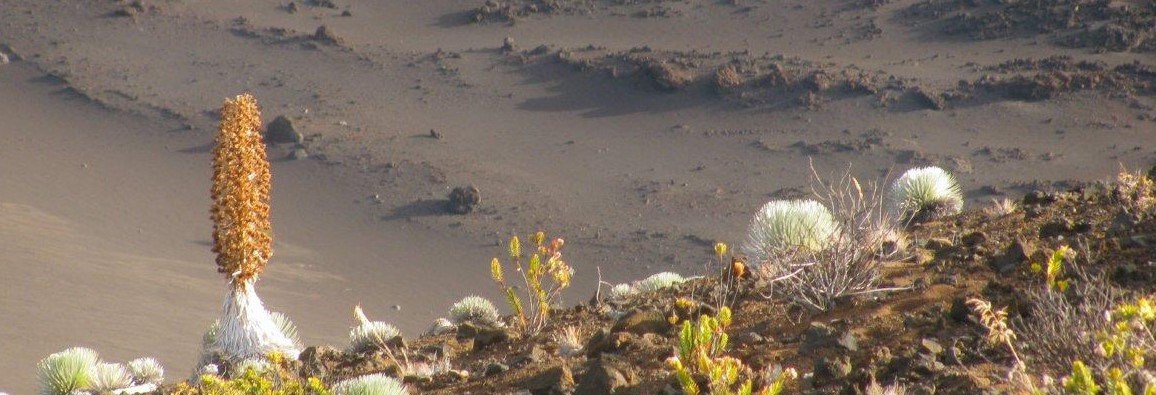
Forest and Kim Starr Those challenges (little soil, arid conditions, intense solar radiation, extreme temperatures) shaped its constant evolution, forcing it to adapt to a fierce, rocky alpine desert, raked by cold winds, until it became the silver, spiky plant called ‘āhinahina or Haleakalā Silversword (Argyroxiphium sandwicense subsp.macrocephalum). Because of the perfect storm of its origins, context, and time, it is an endemic - found here and only here in the high, dry alpine desert over 7000 feet (2130 m) above sea level. Alpine DesertAfter traversing the wetter climate zones to arrive at the park, the alpine desert at the summit can come as a shock. It lies above the clouds. The ground is porous and crumbly, never holding water, and is constantly wrenched between blasting sun and periodic freezes. Rainfall is minimal. A real respect for the tenacity of the ‘āhinahina develops here.Kūpaoa and ‘āhinahina are amazing examples of plants that are native to Hawai‘i and endemic to Haleakalā. That first ancestor seed, or seeds, of the long-ago sunflower colonizer eventually radiated (spread out) into at least 28 different species of plants. This relatively recent division in the family of plants is known as the Silversword Alliance. 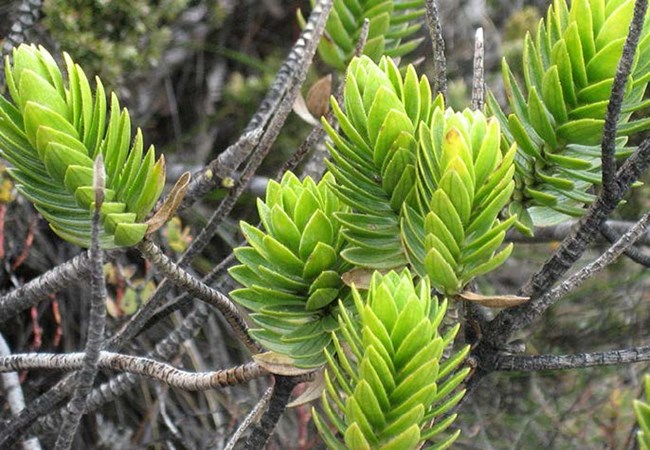
Jim Duggan Kūpaoa(Dubautia menziesii)Endemic Kūpaoa, also called na‘ena‘e, is one of the members of the Silversword Alliance. It can cross-pollinate and hybridize with a nearby ‘āhinahina, creating a plant that manages to look like an exact cross between its parents. Kūpaoa is a smallish, hardy perennial, but somewhat vulnerable to frost. Its soft fragrance was used to scent traditional kapa (bark cloth). 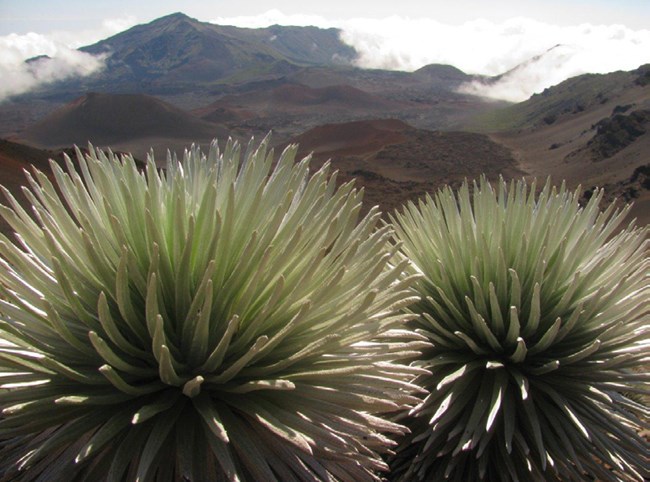
Forest and Kim Starr ‘Āhinahina(Argyroxiphium sandwicense subsp. macrocephalum)Endemic An ‘āhinahina can bloom in its first years of life or may wait several decades to send up the densely fragrant stalk of hundreds of purple sunflower-like blooms. The plant sheds tiny, light seeds and then dies. Furry, reflective (solar radiation is brutal up here), silver spiky leaves catch drifting cloud moisture and aim it toward the plant base. Fragile roots extend around the base; keeping your distance from living ‘āhinahina is the best way to protect them. Goats brought to Hawai‘i after western contact nearly destroyed the ‘āhinahina population. Haleakalā was one of the first national parks to be fenced (in the 1980s) to keep out non-native goats, deer, and pigs.The fence is maintained and continually checked by park staff. 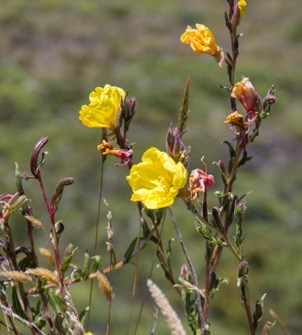
Arne Kaiser Non-nativesEvening primrose (Oenothera biennia) and pine trees are highly visible examples of non- native and invasive species. The many species of pines now found in and around Hosmer Grove were part of an experimental planting in the early 1900s. This experimental grove now threatens to overtake parts of the park if left unmanaged. The bright yellow evening primrose along park roads is native to eastern and central North America, where it is part of an ecosystem that helps to control it. In Haleakalā National Park, resource managers work hard to contain these and other invasives that are free from their natural controls.Some invasives are very harmful so if you plan to hike, please be sure to first clean all gear and hiking shoes of all debris to prevent accidentally introducing any unwanted plant seeds or diseases. Sub-Alpine ShrublandFrom the park entrance to about 9000 feet (2700 m) elevation, the Haleakalā sub-alpine shrublands are a tapestry of native shrubs, ferns, and small woody trees that cover the mountain in countless shades of green. Pūkiawe, ‘ōhelo, nohoanu, and ‘a‘ali‘i are dominant here. Endemic birds such as ‘apapane, ‘amakihi, and nēnē are commonly seen here.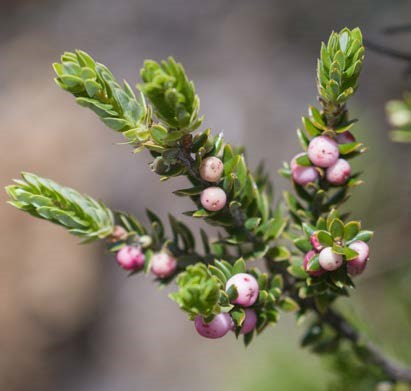
Arne Kaiser Pūkiawe(Leptecophylla tameiameiae)Endemic Tiny pink and white berries festoon this hardy shrub year-round and are food for nēnē, the endangered Hawaiian goose and state bird. Pūkiawe was once found all the way to the shoreline, but now mostly grows in high-elevation protected areas. Cultural uses of pūkiawe included purification in the burning plant's smoke by ali‘i (royalty or chiefs) to lift the kapu (taboo) that forbade mingling with commoners. The berries and stiff greenery are also artfully woven into lei. 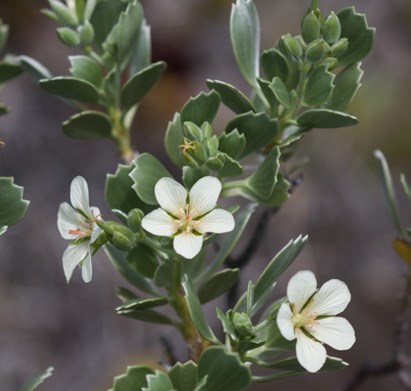
Arne Kaiser Nohoanu(Geranium cuneatum)Endemic These small, silvery geraniums never fail to charm the hiker. Like many high-altitude plants, the silver hairs on this shrubby plant help deflect the strong solar radiation at altitude. Nohoanu is also called hinahina. Hina is the goddess of the silvery, softly-glowing moon. Dew on the plant's reflective leaves can glitter in the headlights, making the drive through the shrublands quite magical. Nohoanu means cold dweller. 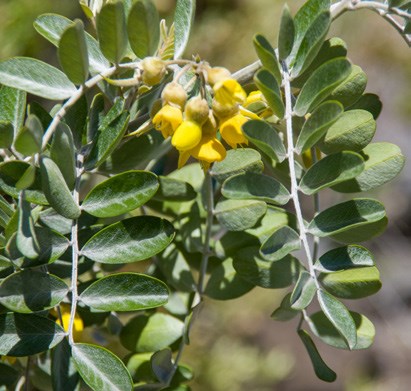
Arne Kaiser Māmane(Sophora chrysophylla)Endemic Māmane is a sturdy small tree with startling yellow flowers. Botany fans will note the typical leaf and flower shapes that indicate māmane as a pea family member. Many native birds utilize the flowers and/or the seeds. Look for ‘apapane and ‘amakihi foraging among the branches. The durable, hard wood of māmane was once used for sled runners, house posts (some māmane grow into large trees), and digging sticks. 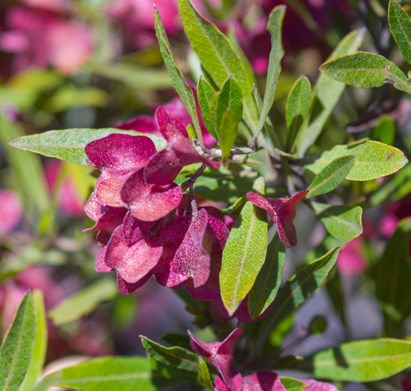
Arne Kaiser ‘A‘ali‘i(Dodonaea viscosa)Native These hardy ‘a‘ali‘i shrubs often grow in exposed areas with beating sun and relentless wind. They are also found in shrubland ravines and even in fairly wet forests. Plants can be 6 to 12 feet (2 to 3.5 m) in height and have one or several main trunks with reddish-brown to blackish gray bark. The multi-colored seed capsules are popular for lei-making and are crushed for dye. ‘A‘ali‘i is sacred to the goddess of hula, Laka, and can be found on her altar in hālau hula (hula schools). 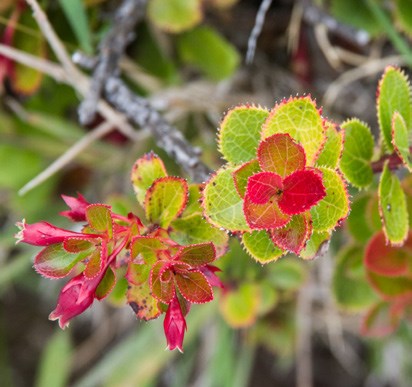
Arne Kaiser ‘Ōhelo(Vaccinium reticulatum)Endemic ‘Ōhelo berries are enjoyed by native birds and are in the same plant group as cranberries and blueberries, Vaccinium. Nēnē rely on the berries' juicy predictability. ‘Ōhelo berries are deep purple, ruby red, or even yellow. These berries are considered sacred to the volcano diety Pele, as they commonly grow near volcanic summits in Hawai‘i, on shrubs of all sizes. New leaf growth is often tinged with red, a natural sunscreen,which protect the eaves from intense sunlight at high elevation. 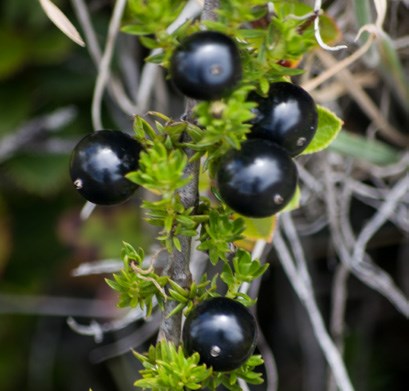
Arne Kaiser Kūkaenēnē(Coprosma ernodeoides)Endemic This striking, low-creeping shrub presents shiny dark purple/black berries after the tiny whitish-yellow flowers are pollinated in the spring and summer. In pre-contact Hawai‘i, a purply/black dye was made from the berries and a yellow dye from the inner bark. These dyes helped to beautify kapa (bark cloth). Kūkaenēnē, sometimes called ‘aiakanēnē, grows best in the open. Its leaves are small and pointy. 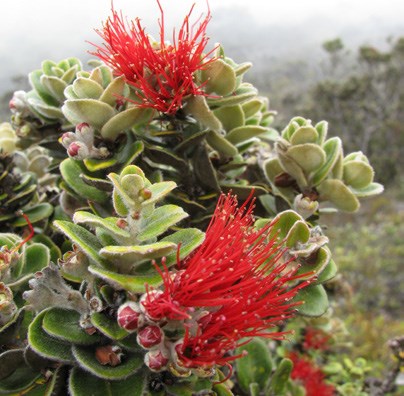
Forest and Kim Starr ‘Ōhi‘a(Metrosideros polymorpha)Endemic The ‘ōhi‘a lehua tree, with its striking crimson blossoms is legendary in Hawaiian story and song. It is the first tree to germinate on a new lava field and can range in size from towering forest giants to small, bonsai-like trees that grow in wetlands. It is considered "the backbone of the Hawaiian forest," since it supports many native bird species. Rapid ‘Ōhi‘a Death, a terrible fungus, presents a very large danger for native ‘ōhi‘a forests. Always clean all hiking gear before heading out on a trail. 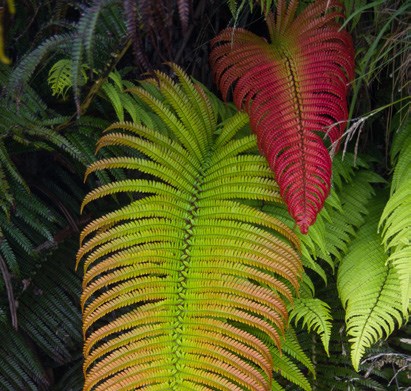
Arne Kaiser ‘Ama‘u(Sadleria cyatheoides)Endemic The stunning red unfurling fronds of young ‘ama‘u tend to stop hikers in their tracks. Red chlorophyll helps protect delicate new tissues from UV rays at high altitudes where this fern grows. The fronds fade to green over time and can be 10 feet (3 m) long. Fronds were used to thatch houses in pre-contact Hawai‘i and various parts of the plant were used in medicines. ‘Ama‘u prefer the wetter pockets in the landscape and are often found tucked against cliff walls. |
Last updated: June 13, 2022
